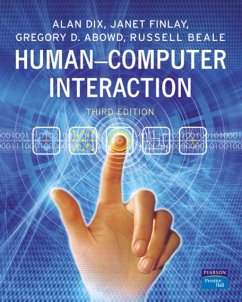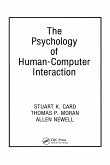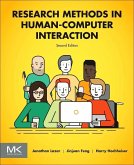The second edition of Human-Computer Interaction established itself as one of the classic textbooks in the area, with its broad coverage and rigorous approach, this new edition builds on the existing strengths of the book, but giving the text a more student-friendly slant and improving the coverage in certain areas.
The revised structure, separating out the introductory and more advanced material will make it easier to use the book on a variety of courses. This new edition now includes chapters on Interaction Design, Universal Access and Rich Interaction, as well as covering the latest developments in ubiquitous computing and Web technologies, making it the ideal text to provide a grounding in HCI theory and practice.
Product Description
The second edition of Human-Computer Interaction established itself as one of the classic textbooks in the area, with its broad coverage and rigorous approach, this new edition builds on the existing strengths of the book, but giving the text a more student-friendly slant and improving the coverage in certain areas. The revised structure, separating out the introductory and more advanced material will make it easier to use the book on a variety of courses. This new edition now includes chapters on Interaction Design, Universal Access and Rich Interaction, as well as covering the latest developments in ubiquitous computing and Web technologies, making it the ideal text to provide a grounding in HCI theory and practice. Features + Benefits
Strong usable design
Gives details of HCI in practice
Comprehensive website at www.hcibook.com
Covers the latest topics
Increased coverage of social and contextual models and theories
New chapters on: Interaction Design, Universal Access and Rich Interaction
Backcover
Much has changed since the first edition of human-computer interaction was published. Ubiquitous computing and rich sensor-filled environments are finding their way out of the laboratory, not just into movies but also into our workplaces and homes. The computer has broken out of its plastic and glass bounds providing us with networked societies where personal computing devices from mobile phones to smart cards fill our pockets and electronic devices surround us at home and work. The web too has grown from a largely academic network into the hub of business and everyday lives. As the distinctions between the physical and the digital, and between work and leisure start to break down, human-computer interaction is also changing radically.
The excitement of these changes is captured in this new edition, which also looks forward to other emerging technologies. However, the book is firmly rooted in strong principles and models independent of the passing technologies of the day: these foundations will be the means by which today's students will understand tomorrow's technology.
The third edition of human-computer interaction can be used for introductory and advanced courses on HCI, Interaction Design, Usability or Interactive Systems Design. It will also prove an invaluable reference for professionals wishing to design usable computing devices.
Accompanying the text is a comprehensive website containing a broad range of material for instructors, students and practitioners, a full text search facility for the book, links to many sites of additional interest and much more: go to www.hcibook.com
New to this edition:
A revised structure, reflecting the growth of HCI as a discipline, separates out basic material suitable for introductory courses from more detailed models and theories.
New chapter on Interaction Design adds material on scenarios and basic navigation design.
New chapter on Universal Design, substantially extending the coverage of this material in the book.
Updated and extended treatment of socio/contextual issues.
Extended and new material on novel interaction, including updated ubicomp material, designing experience, physical sensors and a new chapter on rich interaction.
Updated material on the web including dynamic content and WAP.
Alan Dix is Professor in the Department of Computing, Lancaster, UK. Janet Finlay is Professor at the School of Computing, Leeds Metropolitan University, UK. Gregory Abowd is Assistant Professor in the College of Computing at Georgia Tech, USA. Russell Beale is lecturer at the School of Computer Science, University of Birmingham, UK.
Contents
Foreword
Preface to the third edition
Preface to the second edition
Preface to the first edition
Introduction
Part 1 Foundations
Chapter 1 The human
1.1 Introduction
1.2 Input-output channels
Design Focus: Getting noticed
Design Focus: Where's the middle?
1.3 Human memory
Design Focus: Cashing in
Design Focus: 7 ± 2 revisited
1.4 Thinking: reasoning and problem solving
Design Focus: Human error and false memories
1.5 Emotion
1.6 Individual differences
1.7 Psychology and the design of interactive systems
1.8 Summary
Exercises
Recommended reading
Chapter 2 The computer
2.1 Introduction
Design Focus: Numeric keypads
2.2 Text entry devices
2.3 Positioning, pointing and drawing
2.4 Display devices
Design Focus: Hermes: a situated display
2.5 Devices for virtual reality and 3D interaction
2.6 Physical controls, sensors and special devices
Design Focus: Feeling the road
Design Focus: Smart-Its - making sensors easy
2.7 Paper: printing and scanning
Design Focus: Readability of text
2.8 Memory
2.9 Processing and networks
Design Focus: The myth of the infinitely fast machine
2.10 Summary
Exercises
Recommended reading
Chapter 3 The interaction
3.1 Introduction
3.2 Models of interaction
Design Focus: Video recorder
3.3 Frameworks and HCI
3.4 Ergonomics
Design Focus: Industrial interfaces
3.5 Interaction styles
Design Focus: Navigation in 3D and 2D
3.6 Elements of the WIMP interface
Design Focus: Learning toolbars
3.7 Interactivity
3.8 The context of the interaction
Design Focus: Half the picture?
3.9 Experience, engagement and fun
3.10 Summary
Exercises
Recommended reading
Chapter 4 Paradigms
4.1 Introduction
4.2 Paradigms for interaction
4.3 Summary
Exercises
Recommended reading
Part 2 Design process
Chapter 5 Interaction design basics
5.1 Introduction
5.2 What is design?
5.3 The process of design
5.4 User focus
Design Focus: Cultural probes
5.5 Scenarios
5.6 Navigation design
Design Focus: Beware the big button trap
Design Focus: Modes
5.7 Screen design and layout
Design Focus: Alignment and layout matter
Design Focus: Checking screen colors
5.8 Iteration and prototyping
5.9 Summary
Exercises
Recommended reading
Chapter 6 HCI in the software process
6.1 Introduction
6.2 The software life cycle
6.3 Usability engineering
6.4 Iterative design and prototyping
Design Focus: Prototyping in practice
6.5 Design rationale
6.6 Summary
Exercises
Recommended reading
Chapter 7 Design rules
7.1 Introduction
7.2 Principles to support usability
7.3 Standards
7.4 Guidelines
7.5 Golden rules and heuristics
7.6 HCI patterns
7.7 Summary
Exercises
Recommended reading
Chapter 8 Implementation support
8.1 Introduction
8.2 Elements of windowing systems
8.3 Programming the application
Design Focus: Going with the grain
8.4 Using toolkits
Design Focus: Java and AWT
8.5 User interface management systems
8.6 Summary
Exercises
Recommended reading
Chapter 9 Evaluation techniques
9.1 What is evaluation?
9.2 Goals of evaluation
9.3 Evaluation through expert analysis
9.4 Evaluation through user participation
9.5 Choosing an evaluation method
9.6 Summary
Exercises
Recommended reading
Chapter 10 Universal design
10.1 Introduction
10.2 Universal design principles
10.3 Multi-modal interaction
Design Focus: Designing websites for screen readers
Design Focus: Choosing the right kind of speech
Design Focus: Apple Newton
10.4 Designing for diversity
Design Focus: Mathematics for the blind
10.5 Summary
Exercises
Recommended reading
Chapter 11 User support
11.1 Introduction
11.2 Requirements of user support
11.3 Approaches to user support
11.4 Adaptive help systems
Design Focus: It's good to talk - help from real people
11.5 Designing user support systems
11.6 Summary
Exercises
Recommended reading
Part 3 Models and theories
Chapter 12 Cognitive models
12.1 Introduction
12.2 Goal and task hierarchies
Design Focus: GOMS saves money
12.3 Linguistic models
12.4 The challenge of display-based systems
12.5 Physical and device models
12.6 Cognitive architectures
12.7 Summary
Exercises
Recommended reading
Chapter 13 Socio-organizational issues and stakeholder requirements
13.1 Introduction
13.2 Organizational issues
Design Focus: Implementing workflow in Lotus Notes
13.3 Capturing requirements
Design Focus: Tomorrow's hospital - using participatory design
13.4 Summary
Exercises
Recommended reading
Chapter 14 Communication and collaboration models
14.1 Introduction
14.2 Face-to-face communication
Design Focus: Looking real - Avatar Conference
14.3 Conversation
14.4 Text-based communication
14.5 Group working
14.6 Summary
Exercises
Recommended reading
Chapter 15 Task analysis
15.1 Introduction
15.2 Differences between task analysis and other techniques
15.3 Task decomposition
15.4 Knowledge-based analysis
15.5 Entity-relationship-based techniques
15.6 Sources of information and data collection
15.7 Uses of task analysis
15.8 Summary
Exercises
Recommended reading
Chapter 16 Dialog notations and design
16.1 What is dialog?
16.2 Dialog design notations
16.3 Diagrammatic notations
Design Focus: Using STNs in prototyping
Design Focus: Digital watch - documentation and analysis
16.4 Textual dialog notations
16.5 Dialog semantics
16.6 Dialog analysis and design
16.7 Summary
Exercises
Recommended reading
Chapter 17 Models of the system
17.1 Introduction
17.2 Standard formalisms
17.3 Interaction models
17.4 Continuous behavior
17.5 Summary
Exercises
Recommended reading
Chapter 18 Modeling rich interaction
18.1 Introduction
18.2 Status-event analysis
18.3 Rich contexts
18.4 Low intention and sensor-based interaction
Design Focus: Designing a car courtesy light
18.5 Summary
Exercises
Recommended reading
Part 4 Outside the box
Chapter 19 Groupware
19.1 Introduction
19.2 Groupware systems
19.3 Computer-mediated communication
Design Focus: SMS in action
19.4 Meeting and decision support systems
19.5 Shared applications and artifacts
19.6 Frameworks for groupware
Design Focus: TOWER - workspace awareness
Exercises
Recommended reading
Chapter 20 Ubiquitous computing and augmented realities
20.1 Introduction
20.2 Ubiquitous computing applications research
Design Focus: Ambient Wood - augmenting the physical
Design Focus: Classroom 2000/eClass - deployi
Much has changed since the first edition of human-computer interaction was published. The excitement of these changes is captured in this new edition, which also looks forward to other emerging technologies. However, the book is firmly rooted in strong principles and models independent of the passing technologies of the day.
Hinweis: Dieser Artikel kann nur an eine deutsche Lieferadresse ausgeliefert werden.
The revised structure, separating out the introductory and more advanced material will make it easier to use the book on a variety of courses. This new edition now includes chapters on Interaction Design, Universal Access and Rich Interaction, as well as covering the latest developments in ubiquitous computing and Web technologies, making it the ideal text to provide a grounding in HCI theory and practice.
Product Description
The second edition of Human-Computer Interaction established itself as one of the classic textbooks in the area, with its broad coverage and rigorous approach, this new edition builds on the existing strengths of the book, but giving the text a more student-friendly slant and improving the coverage in certain areas. The revised structure, separating out the introductory and more advanced material will make it easier to use the book on a variety of courses. This new edition now includes chapters on Interaction Design, Universal Access and Rich Interaction, as well as covering the latest developments in ubiquitous computing and Web technologies, making it the ideal text to provide a grounding in HCI theory and practice. Features + Benefits
Strong usable design
Gives details of HCI in practice
Comprehensive website at www.hcibook.com
Covers the latest topics
Increased coverage of social and contextual models and theories
New chapters on: Interaction Design, Universal Access and Rich Interaction
Backcover
Much has changed since the first edition of human-computer interaction was published. Ubiquitous computing and rich sensor-filled environments are finding their way out of the laboratory, not just into movies but also into our workplaces and homes. The computer has broken out of its plastic and glass bounds providing us with networked societies where personal computing devices from mobile phones to smart cards fill our pockets and electronic devices surround us at home and work. The web too has grown from a largely academic network into the hub of business and everyday lives. As the distinctions between the physical and the digital, and between work and leisure start to break down, human-computer interaction is also changing radically.
The excitement of these changes is captured in this new edition, which also looks forward to other emerging technologies. However, the book is firmly rooted in strong principles and models independent of the passing technologies of the day: these foundations will be the means by which today's students will understand tomorrow's technology.
The third edition of human-computer interaction can be used for introductory and advanced courses on HCI, Interaction Design, Usability or Interactive Systems Design. It will also prove an invaluable reference for professionals wishing to design usable computing devices.
Accompanying the text is a comprehensive website containing a broad range of material for instructors, students and practitioners, a full text search facility for the book, links to many sites of additional interest and much more: go to www.hcibook.com
New to this edition:
A revised structure, reflecting the growth of HCI as a discipline, separates out basic material suitable for introductory courses from more detailed models and theories.
New chapter on Interaction Design adds material on scenarios and basic navigation design.
New chapter on Universal Design, substantially extending the coverage of this material in the book.
Updated and extended treatment of socio/contextual issues.
Extended and new material on novel interaction, including updated ubicomp material, designing experience, physical sensors and a new chapter on rich interaction.
Updated material on the web including dynamic content and WAP.
Alan Dix is Professor in the Department of Computing, Lancaster, UK. Janet Finlay is Professor at the School of Computing, Leeds Metropolitan University, UK. Gregory Abowd is Assistant Professor in the College of Computing at Georgia Tech, USA. Russell Beale is lecturer at the School of Computer Science, University of Birmingham, UK.
Contents
Foreword
Preface to the third edition
Preface to the second edition
Preface to the first edition
Introduction
Part 1 Foundations
Chapter 1 The human
1.1 Introduction
1.2 Input-output channels
Design Focus: Getting noticed
Design Focus: Where's the middle?
1.3 Human memory
Design Focus: Cashing in
Design Focus: 7 ± 2 revisited
1.4 Thinking: reasoning and problem solving
Design Focus: Human error and false memories
1.5 Emotion
1.6 Individual differences
1.7 Psychology and the design of interactive systems
1.8 Summary
Exercises
Recommended reading
Chapter 2 The computer
2.1 Introduction
Design Focus: Numeric keypads
2.2 Text entry devices
2.3 Positioning, pointing and drawing
2.4 Display devices
Design Focus: Hermes: a situated display
2.5 Devices for virtual reality and 3D interaction
2.6 Physical controls, sensors and special devices
Design Focus: Feeling the road
Design Focus: Smart-Its - making sensors easy
2.7 Paper: printing and scanning
Design Focus: Readability of text
2.8 Memory
2.9 Processing and networks
Design Focus: The myth of the infinitely fast machine
2.10 Summary
Exercises
Recommended reading
Chapter 3 The interaction
3.1 Introduction
3.2 Models of interaction
Design Focus: Video recorder
3.3 Frameworks and HCI
3.4 Ergonomics
Design Focus: Industrial interfaces
3.5 Interaction styles
Design Focus: Navigation in 3D and 2D
3.6 Elements of the WIMP interface
Design Focus: Learning toolbars
3.7 Interactivity
3.8 The context of the interaction
Design Focus: Half the picture?
3.9 Experience, engagement and fun
3.10 Summary
Exercises
Recommended reading
Chapter 4 Paradigms
4.1 Introduction
4.2 Paradigms for interaction
4.3 Summary
Exercises
Recommended reading
Part 2 Design process
Chapter 5 Interaction design basics
5.1 Introduction
5.2 What is design?
5.3 The process of design
5.4 User focus
Design Focus: Cultural probes
5.5 Scenarios
5.6 Navigation design
Design Focus: Beware the big button trap
Design Focus: Modes
5.7 Screen design and layout
Design Focus: Alignment and layout matter
Design Focus: Checking screen colors
5.8 Iteration and prototyping
5.9 Summary
Exercises
Recommended reading
Chapter 6 HCI in the software process
6.1 Introduction
6.2 The software life cycle
6.3 Usability engineering
6.4 Iterative design and prototyping
Design Focus: Prototyping in practice
6.5 Design rationale
6.6 Summary
Exercises
Recommended reading
Chapter 7 Design rules
7.1 Introduction
7.2 Principles to support usability
7.3 Standards
7.4 Guidelines
7.5 Golden rules and heuristics
7.6 HCI patterns
7.7 Summary
Exercises
Recommended reading
Chapter 8 Implementation support
8.1 Introduction
8.2 Elements of windowing systems
8.3 Programming the application
Design Focus: Going with the grain
8.4 Using toolkits
Design Focus: Java and AWT
8.5 User interface management systems
8.6 Summary
Exercises
Recommended reading
Chapter 9 Evaluation techniques
9.1 What is evaluation?
9.2 Goals of evaluation
9.3 Evaluation through expert analysis
9.4 Evaluation through user participation
9.5 Choosing an evaluation method
9.6 Summary
Exercises
Recommended reading
Chapter 10 Universal design
10.1 Introduction
10.2 Universal design principles
10.3 Multi-modal interaction
Design Focus: Designing websites for screen readers
Design Focus: Choosing the right kind of speech
Design Focus: Apple Newton
10.4 Designing for diversity
Design Focus: Mathematics for the blind
10.5 Summary
Exercises
Recommended reading
Chapter 11 User support
11.1 Introduction
11.2 Requirements of user support
11.3 Approaches to user support
11.4 Adaptive help systems
Design Focus: It's good to talk - help from real people
11.5 Designing user support systems
11.6 Summary
Exercises
Recommended reading
Part 3 Models and theories
Chapter 12 Cognitive models
12.1 Introduction
12.2 Goal and task hierarchies
Design Focus: GOMS saves money
12.3 Linguistic models
12.4 The challenge of display-based systems
12.5 Physical and device models
12.6 Cognitive architectures
12.7 Summary
Exercises
Recommended reading
Chapter 13 Socio-organizational issues and stakeholder requirements
13.1 Introduction
13.2 Organizational issues
Design Focus: Implementing workflow in Lotus Notes
13.3 Capturing requirements
Design Focus: Tomorrow's hospital - using participatory design
13.4 Summary
Exercises
Recommended reading
Chapter 14 Communication and collaboration models
14.1 Introduction
14.2 Face-to-face communication
Design Focus: Looking real - Avatar Conference
14.3 Conversation
14.4 Text-based communication
14.5 Group working
14.6 Summary
Exercises
Recommended reading
Chapter 15 Task analysis
15.1 Introduction
15.2 Differences between task analysis and other techniques
15.3 Task decomposition
15.4 Knowledge-based analysis
15.5 Entity-relationship-based techniques
15.6 Sources of information and data collection
15.7 Uses of task analysis
15.8 Summary
Exercises
Recommended reading
Chapter 16 Dialog notations and design
16.1 What is dialog?
16.2 Dialog design notations
16.3 Diagrammatic notations
Design Focus: Using STNs in prototyping
Design Focus: Digital watch - documentation and analysis
16.4 Textual dialog notations
16.5 Dialog semantics
16.6 Dialog analysis and design
16.7 Summary
Exercises
Recommended reading
Chapter 17 Models of the system
17.1 Introduction
17.2 Standard formalisms
17.3 Interaction models
17.4 Continuous behavior
17.5 Summary
Exercises
Recommended reading
Chapter 18 Modeling rich interaction
18.1 Introduction
18.2 Status-event analysis
18.3 Rich contexts
18.4 Low intention and sensor-based interaction
Design Focus: Designing a car courtesy light
18.5 Summary
Exercises
Recommended reading
Part 4 Outside the box
Chapter 19 Groupware
19.1 Introduction
19.2 Groupware systems
19.3 Computer-mediated communication
Design Focus: SMS in action
19.4 Meeting and decision support systems
19.5 Shared applications and artifacts
19.6 Frameworks for groupware
Design Focus: TOWER - workspace awareness
Exercises
Recommended reading
Chapter 20 Ubiquitous computing and augmented realities
20.1 Introduction
20.2 Ubiquitous computing applications research
Design Focus: Ambient Wood - augmenting the physical
Design Focus: Classroom 2000/eClass - deployi
Much has changed since the first edition of human-computer interaction was published. The excitement of these changes is captured in this new edition, which also looks forward to other emerging technologies. However, the book is firmly rooted in strong principles and models independent of the passing technologies of the day.
Hinweis: Dieser Artikel kann nur an eine deutsche Lieferadresse ausgeliefert werden.








